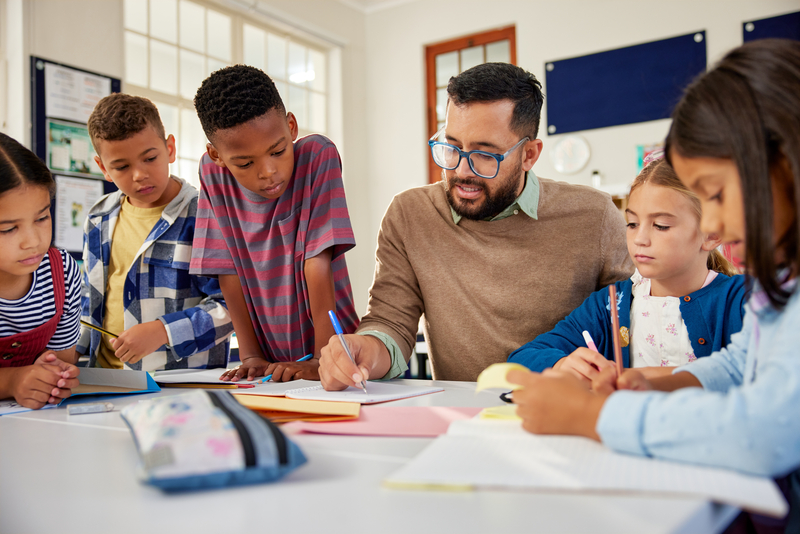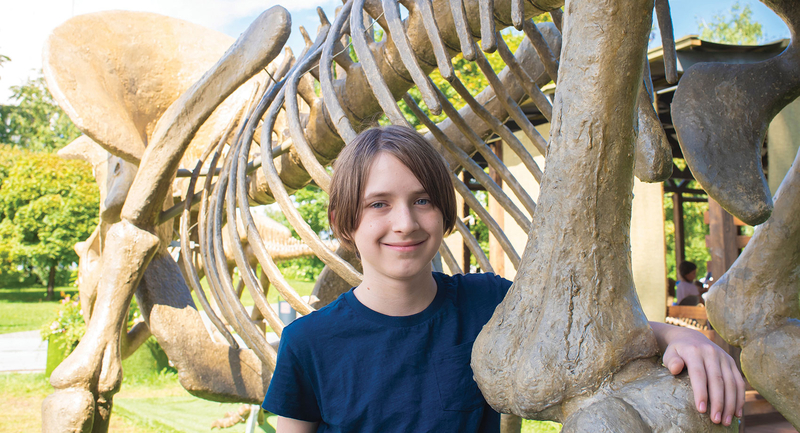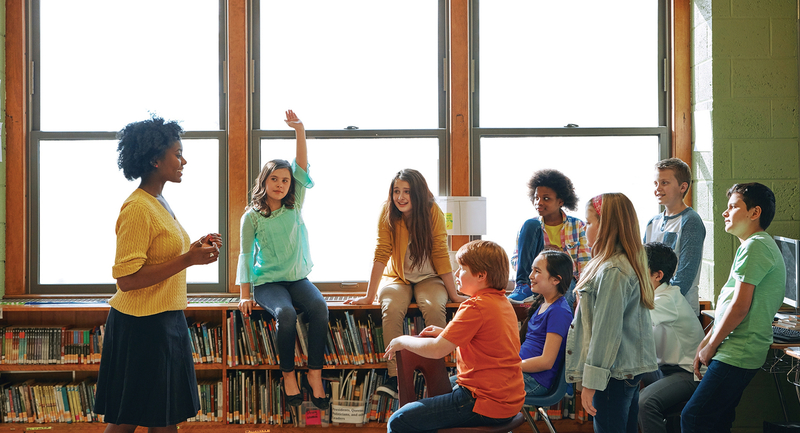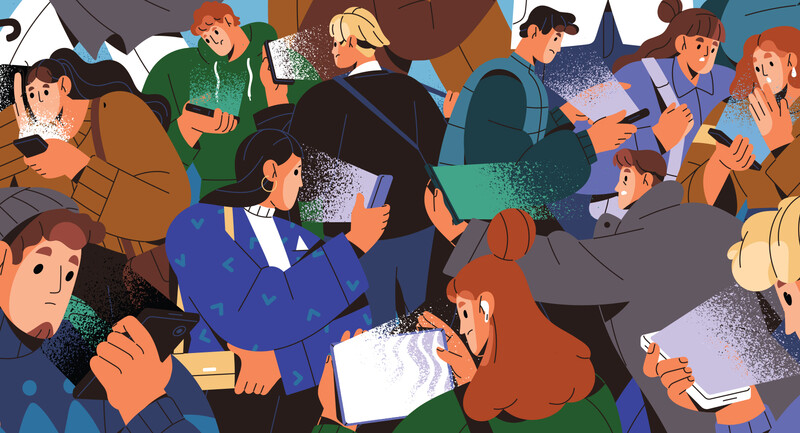As teacher educators, we have heard far too many times the same painful observation from pre-service high school teachers of different content areas. In the AP classes the pre-service teachers observe, high school students are working in small groups and engaging in rich conversations around content. But in the lower-level college-prep courses in the same school, they observe high school students seated in rows, working silently on packets. The pre-service teachers also share that most or all the students in the AP classes are white, while most or all the students in the college-prep courses are students of color. When we ask why they think this is happening, they say their host teacher thinks the college-prep kids “can’t handle” activities like classroom discussion. This sentiment is echoed by research on teachers’ attitudes and beliefs about students of color engaging in student-centered instructional approaches (Woodard & Schutz, 2020).
This harmful, often racist line of thinking about who can handle classroom discussion or talk and who cannot is one that school leaders need to pay attention to and attempt to change. Yet, of all the pernicious beliefs in classrooms that need revision, this one about talk may be slightly easier to address. Research shows that there is a strong connection between talk and learning in the content areas:
Discussion is central to developing scientific reasoning and conceptual understanding (Andriessen, 2006; Osborne, 2010).
Discussion boosts students’ achievement and engagement in math (Sims, 2008).
Discussion improves learning in history more than teacher-delivered instruction (Wanzek et al., 2014).
The connection between talk and literacy is also well-documented. Students who participate in class discussions have improved written arguments (Firetto et al., 2019) and improved text comprehension (Murphy et al., 2009). Given these multiple connections, it is easy to argue that talk promotes literacy in the content areas.
Students who participate in class discussions have improved written arguments and improved text comprehension.
To illustrate this, let’s look at two real-life accounts from high school classrooms. In one social studies class, a pre-service teacher invited students to read an excerpt from the work of Thomas Hobbes, a 17th century political philosopher, and discuss whether they agreed with Hobbes’s claim that a state of nature is characterized by conflict and competition. Two students opened the discussion agreeing with Hobbes’s claim and shared examples from their own lives when competition was “what we had to do” and inspired them to work harder. A third student disagreed with their interpretations of Hobbes:
He wasn’t looking as if it was like a real, like, competition . . . what you would expect to be a competition wasn’t actually a competition. . . during his time, his competition was who was going to be the higher person in charge. . . who is going to take over this country. . . . They were all fighting to see who owned the most land. And then say to people who once were friends. . . they would become enemies because they wanted the same type of land and they both couldn’t have it.
Through talk, this student was able to contextualize Hobbes, to situate his notion of competition in the 17th century. This exchange allowed for a deeper reading of the text and its historical significance.
In the second account, a chemistry class, students in a small group thumbed through a reading packet. In their discussion, they struggled to explain the mechanism behind how instant hot packs get hot, as you see from this student’s comment:
Well, obviously it’s changing from a liquid to a solid and it’s exothermic because it gives off heat, but I don’t really know why necessarily. I mean I know how [the reading] talks about how water goes down to 32 degrees Fahrenheit until all of it’s frozen, and then it drops. . . . So that’s probably, I don’t know, is there a capacity of water to only go down to 32 degrees?
While this student did not have a breakthrough in comprehension about hot packs, the opportunity to process the text through talk allowed the student to identify gaps in knowledge, ask questions, and make suggestions that could eventually lead to collective sense-making of the packs’ mechanism.
Classroom talk not only promotes literacy—the ability to read and write—across content areas, but is also necessary for literacy in the content areas.
These examples support the argument, made by many practitioners and researchers, that classroom talk not only promotes literacy—the ability to read and write—across content areas, but is also necessary for literacy in the content areas. Others go even further, asserting that talk is literacy, as seen in the NCTE Standing Committee on Global Citizenship’s definition:
. . . literacy is the way that we interact with the world around us, how we shape it and are shaped by it. It is how we communicate with others via reading and writing, but also by speaking, listening, and creating. It is how we articulate our experience in the world and declare, “We Are Here!” (Peterson, 2020)
We lean into this more inclusive definition of literacy, one that recognizes that we make meaning of not only the texts we encounter, but also our larger world. And talking is as critical to this meaning-making as reading and writing.
Talk Across the Disciplines
Over a span of three years, the three of us, along with four other researchers with expertise in different disciplines, analyzed and rated 48 videos of classroom discussions in math, science, social studies, and ELA classrooms, ranging from early elementary through high school. Our team came together around our shared experiences working with pre-service and in-service teachers and our shared interests in developing and supporting teachers of all content areas as effective facilitators of talk in the classroom. We agreed that the talk we want teachers to facilitate promotes not only the learning of content and language, the understanding of complex concepts, and the development of reasoning, but also equity and a sense of belonging among students. One of our goals in this project was to identify how teachers across disciplines make possible the kind of talk that empowers students to make meaning of texts and their world and affirms who they are.
In our analysis of the videos, our team found that talk that promotes learning, understanding, and reasoning in any content area is best facilitated when a teacher:
Asks open-ended, authentic, and discussable questions.
Presses for reasoning (i.e., Why do you think that?) and clarification.
Encourages students to engage with one another (e.g., agree/disagree).
Affirms, acknowledges, or shows interest in student responses.
Provides instructional (re)focus (e.g., brings students back to the text).
Conversely, such talk in the content areas is stifled when a teacher:
Asks closed or test questions.
Dominates the conversation.
Provides the right answer, asks leading questions, or evaluates student responses as correct or incorrect.
Moves on too quickly or shuts down the conversation.
We also noted that the most effective discussions are ones that support epistemic progress. Golding (2017) described “epistemic philosophical progress” as “getting better ideas, insights, or understandings” (p. 65). Epistemic progress in science, for example, might look like a group of students unpacking a confusion or question or getting closer to an accurate scientific explanation of a phenomenon. Let’s say students are trying to explain what is happening when they drink from a straw. By talking to one another, they move away from the idea that liquid is being pulled into their mouths and toward the idea that liquid is being pushed into their mouths, which is more accurate, as air molecules cannot pull, they can only push. Epistemic progress in a history class might look like a student’s thinking about a historical figure becoming more nuanced. Say a student was considering the question: Did Black lives matter to Abraham Lincoln? After reading and discussing select primary sources and weighing the evidence for both sides, a student may move from, “Of course Black lives mattered to Lincoln” to “I’m not sure anymore.”
Our early findings suggest that helping students make epistemic progress, in any content area, in a classroom discussion requires more than the strategies listed above. Teachers must have both the content knowledge and deep understanding of disciplinary concepts so that they can do the heavy lifting of figuring out what targeted question to ask, or which student comment to highlight, or what small piece of information to add when students are stuck. By promoting epistemic progress, discussions make the most exciting, important, and complex ideas and explanations found in texts, and in our broader world, more accessible to students.
Centering Students in Classroom Discussion
Too often in the videos we watched, teachers dominated the discussion, led students toward the “right” answer, or elaborated upon a student’s comment with evidence and reasoning, instead of having the student do the critical thinking. For example, in a 5th grade classroom discussing a text about hurricanes, one student mentioned that toys could become missiles. The teacher then elaborated:
Yeah, so right back here in our story, is this what you’re talking about, Eric? Hurricane-force winds rip pieces off roofs, tear the siding off houses, and carry off toys, building materials, and other items left outside. These become missiles during a hurricane, dangerous to people as well as property.
Here, the student offered the initial idea, but the teacher did the cognitive work of finding the point in the text and elaborating upon it instead of asking questions to prompt the student to make those connections.
Talk has the potential to make content, understanding, and language more accessible to students.
The challenge of teacher facilitation is offering students enough support to make epistemic progress or reach the learning goal, while simultaneously allowing students to develop agency and ownership over the discussion. A few ways to do this well, as we observed, include taking seriously what students say and encouraging others to do the same; being careful not to misrepresent students’ ideas; and using students’ ideas to help the whole group advance their thinking (which may include curating students’ comments and highlighting and unpacking incorrect or partial ideas). As the demands for teachers to engage students in these types of discussions increase (National Governors Association, 2010), professional development could play a role in supporting teachers in facilitating such discussions.
Talk Is Equity
A teacher who takes the time to facilitate classroom discussions in which all students contribute their thinking and meaningfully engage with others’ thinking, perhaps not every day but consistently over time, is doing more than just implementing another instructional strategy. That teacher is taking a justice-focused stance and disrupting inequities that are perpetuated in classrooms everywhere. Talk has the potential to make content, understanding, and language more accessible to students; make standards-based learning objectives and other high expectations more reachable; and make classroom environments more engaging, more collaborative, and safer for students of all identities.
No one should think it is OK for students in one class to get frequent access to rich talk about content, while students in the other class down the hall are consistently denied the opportunity to strengthen their knowledge, reasoning, and sense of self through talk. It is time for school leaders and teachers across the disciplines to take talk as seriously as reading and writing. Doing so will be a major step toward advancing racial justice in schools.
Authors' Note: The research reported in this article was made possible (in part) by a grant from the Spencer Foundation #202000131. The views expressed are those of the authors and do not necessarily reflect the views of the Spencer Foundation.
Reflect & Discuss
➛ How much of a priority
is academic talk in your
classroom or school? Is it
enough?
➛ Evaluate your own methods
of facilitating discussion in the
classroom. Do you open the
conversation or stifle it? How
can you adapt?









